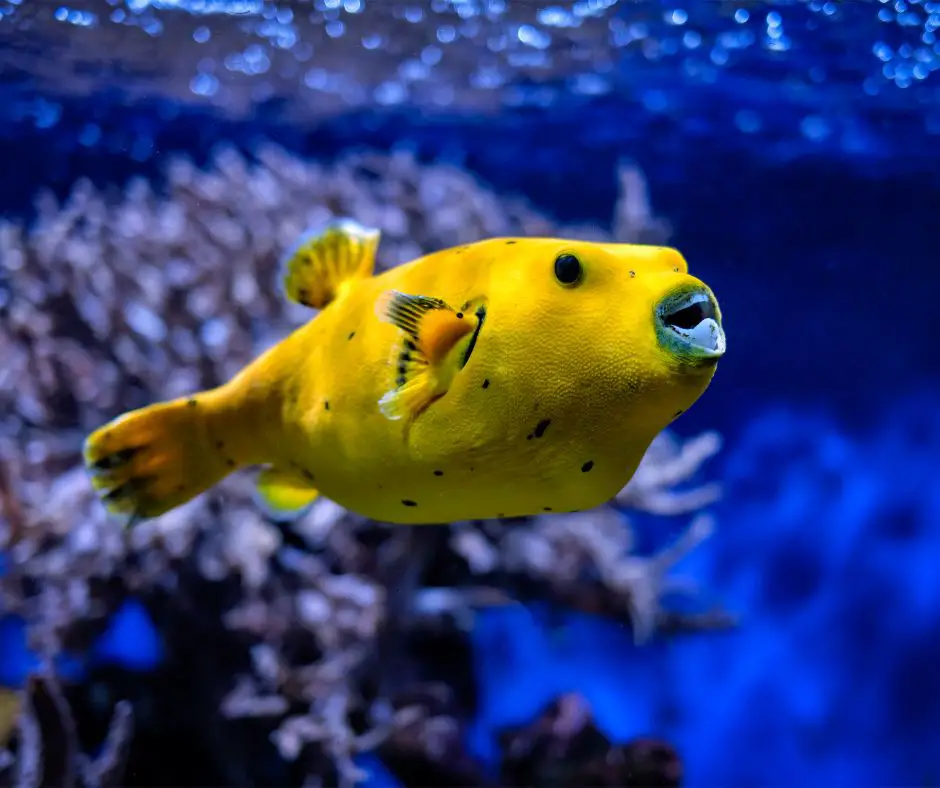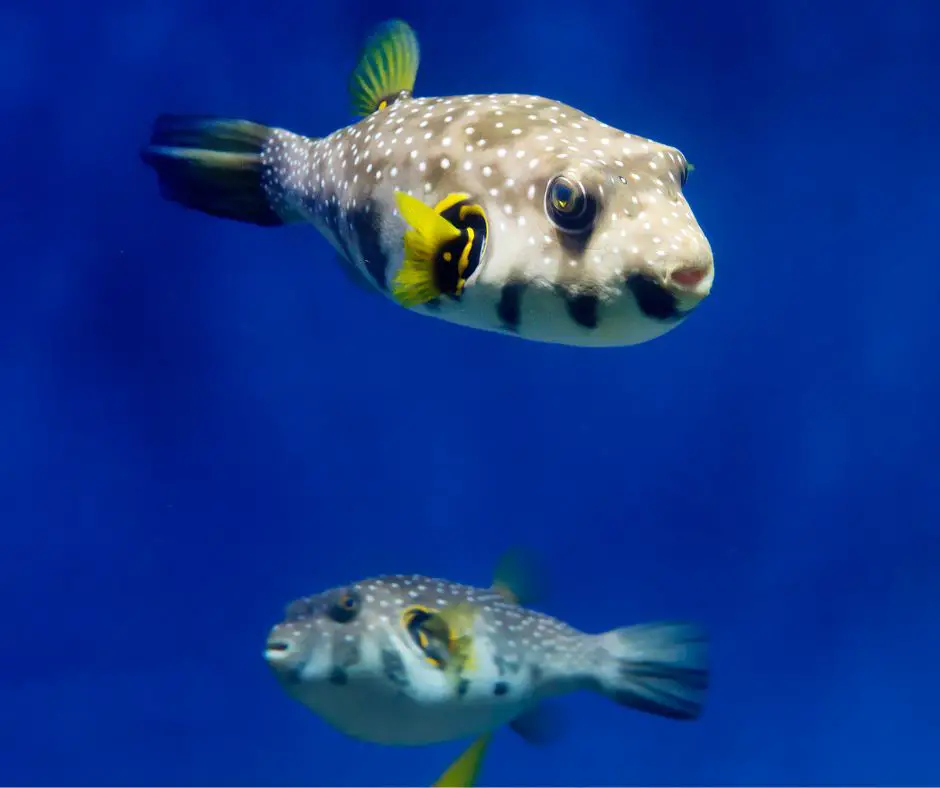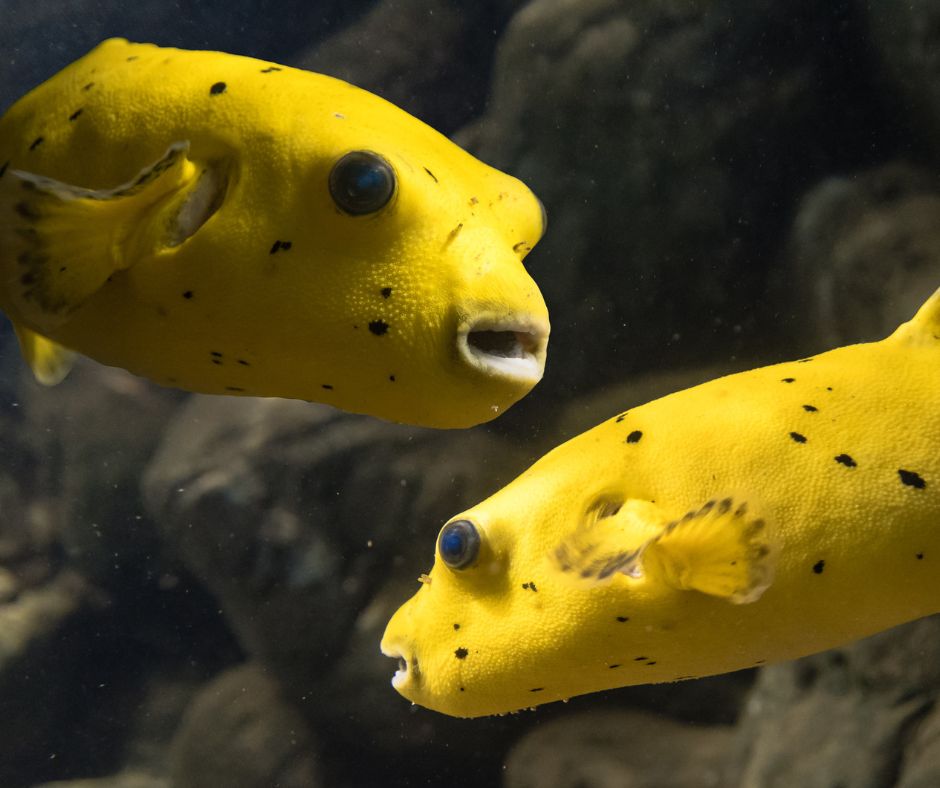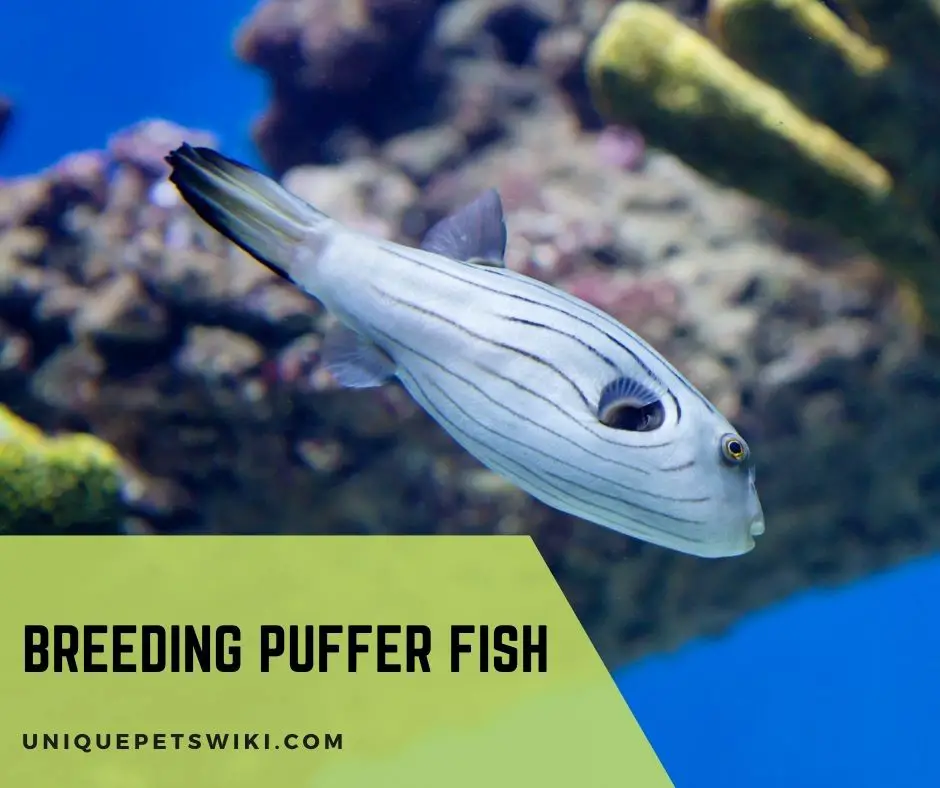Breeding puffer fish isn’t such a daunting task as many would think. So if you are considering breeding your puffer fish, then you have come to the right blog.
To get started, you’ll need to ensure that your breeding pair (male and female) are sexually mature. Puffer fish are ready to breed at about 7 – 8 months. However, they will attain sexual maturity from 4 to 5 years of age.
Once this is done, proceed to set up a breeding tank where the pair can engage in mating rituals that will enable the female to spawn some eggs.
Depending on the puffer fish species that you are breeding, puffers typically spawn between 10 to 1000 eggs.
If you end up with 1000 fry, that is a lot of puffers to care for. So you must be prepared to care for puffers of such number till adulthood.
That said, let’s get into the breeding procedures in detail.
Contents
Can You Breed Puffer Fish in Captivity?
Yes, you can breed puffer fish in captivity. They are quite easy to breed.
Puffer fish species such as the dwarf or pea puffer fish, red-eyed puffer fish, and the figure 8 puffer fish which are commonly kept in homes as pets have been successfully bred in captivity.
Where success rate is limited (low), lack of adequate information and experience is likely to be the cause. To avoid this read on to learn how you can breed your puffers.

How Do Puffer Fish Reproduce?
There are about 120 species of puffer fish and each species has its unique mating/breeding behavior.
Aside from the popular white-spotted pufferfish (Torquigener albomaculosus) known for its ability to construct large, geometric circles in the sand to impress the female for mating, other puffer fish species simply move to the shallow part of the water usually close to the shore and spawn their eggs on plants.
Irrespective of the mating behavior displayed, puffer fish fertilized their eggs externally.
Thus, once the male has succeeded in making the female spawn some eggs, he stays back to watch the eggs till they hatch while the female disappears immediately after spawning.
In a single spawn, puffers can spawn between 10 – 1000 eggs and even more. How many eggs your puffer fish will lay at a time is a factor of its species, size, and to some extent the quality of foods fed.
For instance, the pea puffer fish (also called the dwarf puffer) are small in size hence, they lay only a few eggs in a single spawn, usually about 10 or less.
On the flip side, species such as the spotted green pufferfish (Tetraodon nigroviridis) can spawn as many as 1000 eggs or more.
Puffer fish breed from spring to summer, usually from October to March with the peak period being in December.
Therefore, the life cycle of a puffer fish begins as an egg, spans across to maturity, and then down to reproduction.
Interestingly, if you have a mature male and one or more mature females in the same tank, they may end up spawning all year round.
At What Age do Puffers Begin to Breed?
Before you can breed your male and female puffer fish, make sure they are sexually mature and ready to reproduce. Typically, your puffer fish will be ready for breeding when he/she is about 7 or 8 months old.

A-Z Breeding Puffer Fish Guide
Both in the wild and in captivity, it’s not difficult to breed a puffer fish, especially the pea puffers. Puffer fish breeding typically consists of four stages:
- First, the chasing of the female by the male until she finally accepts his advances,
- The female swam towards a spot beneath the cover of plants with him to spawn some eggs, and
- The female then disappears for the male to watch over the eggs until they hatch.
For someone looking forward to breeding your puffers, the first thing you must do to encourage spawning in your puffers is to set up a breeding tank and also a new tank where you’ll house your fry (puffer babies).
In doing this, one of the challenges you may encounter is being able to select a pair of male and a female since both genders look the same with very little difference. Let’s look at these stages and factors in detail.
Puffer Fish as Pets. Freshwater Puffer Fish Facts
- Lang, Elliott (Author)
- English (Publication Language)
- 138 Pages - 03/05/2013 (Publication Date) - IMB Publishing (Publisher)
Last update on 2022-12-29 / Affiliate links / Images from Amazon Product Advertising API
Prepare a Pair of Puffer Fish
To breed puffer fish, you’ll need at least three of them (one male and two females) in a clean tank with the right water conditions. It’s nearly impossible to breed juvenile or immature puffers because they aren’t fully developed enough to show sexual distinctions.
As a result, your puffer must be at least 8 months old to be properly sexed and even older to be bred. At 8 months old and above, they are old enough to begin displaying the distinct physical characteristics required to appropriately sex them.
Males of pea puffer fish, for example, are brighter in color, with a black or dark brown stripe along the stomach and brilliant blue wrinkles around the eyes. Females are rounder, less brightly colored, and have a more greenish hue.
Breeding Tank Setup
Once you have gender your puffers and are sure you have a male and female, the next thing you’ll need is to set up a clean tank with the correct water parameters.
A minimum tank of 10-gallon is what you’ll need. Run a filter on the breeding tank and set the temperature in the tank to be slightly warmer to encourage breeding (spawning). Ideally, keep the temperature at 79°F (26°C).
To ensure that your female(s) don’t get stressed out from being hunted by the males, provide lots of hides and live plants where the female can hide and spawn her eggs on. Pants such as java moss or similar are a good source of live plants.
Prior to and during breeding, ensure you feed them only high-quality, live, protein-rich foods such as live snails and bloodworms 4 or 5 times a day.
Waiting for Mating Rituals
Males of all puffer species become more aggressive and territorial when it’s time to spawn, with the exception of white-spotted pufferfish, which have a mating ritual that differs from that of other puffer species.
To assert dominance and the right to mate with the females, they will typically chase and attack one other. They’ll also pursue the females, attempting to get them into a safe, covered area where they can breed.
When female puffers are ready to spawn, their bodies become rounder in the middle. They’ll also spend more time hiding among the plants or at the bottom of the tank, looking for a safe location to deposit their eggs.
After that, the females will disappear, while the males will keep watch over the eggs until they hatch. This process usually takes about two days. Afterward, the eggs take roughly 5 days to hatch.

Caring for Puffer Eggs
When you notice that your female has spawned some eggs, as advised, leave the eggs in the tank for 36 hours (about 2 days) until they hatch.
What do puffer eggs look like? While most puffer fish species have yellow embryos enclosed in a white transparent shell, the pea puffer fish eggs are almost transparent and small, measuring only about 1mm. The eggs just settle to the bottom of the tank once they are spawned and are not sticky.
While waiting for the eggs to hatch, ensure that your water temperature is maintained at 79°F (26°C) or 82°F (29°C) at most and it should not fluctuate as this can make the eggs not hatch. When the eggs are hatched you can then separate them into a new tank.
Move Puffer Fish From The Breeding Tank
Since puffer fish fertilize their eggs externally, to ensure that all eggs are fertilized and viable, we recommend that you leave the eggs in the tank till they are hatch.
Once the eggs are hatched, you need to get them to a new tank that you have already prepared for the fry. Using a turkey baster suck up the fry from the breeding tank to their new tank.
The reason for getting the fry a new home is to avoid the older puffers (the parents) from eating them up, especially when they are hungry.
FREESEA 25 Watt Aquarium Fish Tank Heater
- ★【25 Watt Heater】: This Aquarium heater is suitable for 1 to 5 gallons aquariums, Length - 6.8 inch,voltage 110-120V, power cord is 4.0 ft, please choose the right wattage aquarium heater according to our size chart.
- ★【Temperature range】: 63°F~95°F , It is very easy to adjust the temperature you need, we also deliberately give each customer a free diving thermometer, you can observe the water temperature of the fish tank at any time.
- ★【Intelligent temperature control】: Automatic constant temperature function, when water temperature reaches to specified temperature value, heater will automatically stop heating, when water temperature is lower than the set temperature, heater will automatically start heating. Furthermore, Automatic safety shut-off feature, and overheating protection.
- ★【Note】: 1. Aquarium heater is 100% submersible use only, during its heating time, heater must be 100% submerged into the water.,Please unplug the power supply when cleaning the fish tank or aquarium water changes. 2. Heater rod is suitable for people over 16 years of age. Children or minors should be under adult guidance or supervision.
- ★【SATISFACTION GUARANTEED】: Gain the confidence to go hard with us! Our Aquarium Heater is built with durability in mind and safety for every design, In the remote possibility that you’re not satisfied with our product, just contact us, and we will gladly give you a new Aquarium Heater replacement. 12 Month Warranty and 24 Hour Professional After-sales Service.
Last update on 2022-12-30 / Affiliate links / Images from Amazon Product Advertising API
Care for Baby Puffer Fish
Most puffer fish species are saltwater, others are freshwater, and some can do well in brackish water. Before you set up a new home for your fry, ensure you know what water type your puffer species live in the wild. Simulate this environment in captivity and start feeding them.
Refer to this article for a proper guide on how to set up an ideal puffer fish tank based on the species you are keeping.
Feed the fry infusoria, live brine, cyclops, fairy shrimp nauplii, and other tiny, moving crustaceans until they’re old enough to seek for snails on their own or eat frozen brine shrimp.
Keep the tank clean and the temperatures consistent. keep in mind that juvenile fish are more susceptible to variations in temperature.
Conclusion
In general, the puffer fish is a highly unique and interesting creature. Breeding these fish is not difficult, especially if you have enough information at your disposal.
For many years, many pet enthusiasts have ventured into breeding puffer fish in captivity.
One of the species that is mostly bred is the pea puffers making them readily available for purchase even in cities where puffer importation is illegal.
Therefore, if you want to breed your puffers, ensure you do it by following the steps discussed in this article.


